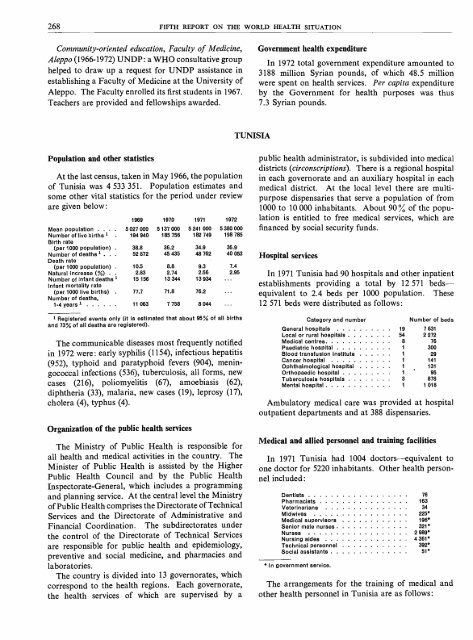FIFTH REPORT - World Health Organization
FIFTH REPORT - World Health Organization
FIFTH REPORT - World Health Organization
Create successful ePaper yourself
Turn your PDF publications into a flip-book with our unique Google optimized e-Paper software.
268 <strong>FIFTH</strong> <strong>REPORT</strong> ON THE WORLD HEALTH SITUATION<br />
Community- oriented education, Faculty of Medicine,<br />
Aleppo (1966 -1972) UNDP: a WHO consultative group<br />
helped to draw up a request for UNDP assistance in<br />
establishing a Faculty of Medicine at the University of<br />
Aleppo. The Faculty enrolled its first students in 1967.<br />
Teachers are provided and fellowships awarded.<br />
Government health expenditure<br />
In 1972 total government expenditure amounted to<br />
3188 million Syrian pounds, of which 48.5 million<br />
were spent on health services. Per capita expenditure<br />
by the Government for health purposes was thus<br />
7.3 Syrian pounds.<br />
TUNISIA<br />
Population and other statistics<br />
At the last census, taken in May 1966, the population<br />
of Tunisia was 4 533 351. Population estimates and<br />
some other vital statistics for the period under review<br />
are given below:<br />
1969 1970 1971 1972<br />
.<br />
Mean population . 5 027 000 5 137 000 5241 000 5 380 000<br />
Number of live births 1 . 194 940 185 756 182 749 198 785<br />
Birth rate<br />
(per 1000 population) . 38.8 36.2 34.9 36.9<br />
Number of deaths' . . 52872 45435 48762 40053<br />
Death rate<br />
(per 1000 population) . 10.5 8.8 9.3 7.4<br />
Natural increase ( %) 2.83 2.74 2.56 2.95<br />
Number of infant deaths 1 15156 13 344 13 934 ...<br />
Infant mortality rate<br />
(per 1000 live births) 77.7 71.8 76.2<br />
Number of deaths,<br />
1 -4 years 1 11 063 7 758 8 044<br />
Registered events only (it is estimated<br />
and 73% of all deaths are registered).<br />
The communicable diseases most frequently notified<br />
in 1972 were: early syphilis (1154), infectious hepatitis<br />
(952), typhoid and paratyphoid fevers (904), meningococcal<br />
infections (536), tuberculosis, all forms, new<br />
cases (216), poliomyelitis (67), amoebiasis (62),<br />
diphtheria (33), malaria, new cases (19), leprosy (17),<br />
cholera (4), typhus (4).<br />
<strong>Organization</strong> of the public health services<br />
The Ministry of Public <strong>Health</strong> is responsible for<br />
all health and medical activities in the country. The<br />
Minister of Public <strong>Health</strong> is assisted by the Higher<br />
Public <strong>Health</strong> Council and by the Public <strong>Health</strong><br />
Inspectorate- General, which includes a programming<br />
and planning service. At the central level the Ministry<br />
of Public <strong>Health</strong> comprises the Directorate of Technical<br />
Services and the Directorate of Administrative and<br />
Financial Coordination. The subdirectorates under<br />
the control of the Directorate of Technical Services<br />
are responsible for public health and epidemiology,<br />
preventive and social medicine, and pharmacies and<br />
laboratories.<br />
The country is divided into 13 governorates, which<br />
correspond to the health regions. Each governorate,<br />
the health services of which are supervised by a<br />
public health administrator, is subdivided into medical<br />
districts (circonscriptions). There is a regional hospital<br />
in each governorate and an auxiliary hospital in each<br />
medical district. At the local level there are multipurpose<br />
dispensaries that serve a population of from<br />
1000 to 10 000 inhabitants. About 90 % of the population<br />
is entitled to free medical services, which are<br />
financed by social security funds.<br />
Hospital services<br />
In 1971 Tunisia had 90 hospitals and other inpatient<br />
establishments providing a total by 12 571 beds -<br />
equivalent to 2.4 beds per 1000 population. These<br />
12 571 beds were distributed as follows:<br />
Category and number<br />
Number of beds<br />
General hospitals 19 7631<br />
Local or rural hospitals 54 2 272<br />
Medical centres 8 76<br />
Paediatric hospital 1 300<br />
Blood transfusion institute 1 29<br />
Cancer hospital 1 141<br />
Ophthalmological hospital 1 131<br />
Orthopaedic hospital 1 95<br />
Tuberculosis hospitals 3 878<br />
Mental hospital 1 1 018<br />
Ambulatory medical care was provided at hospital<br />
outpatient departments and at 388 dispensaries.<br />
Medical and allied personnel and training facilities<br />
In 1971 Tunisia had 1004 doctors -equivalent to<br />
one doctor for 5220 inhabitants. Other health personnel<br />
included:<br />
Dentists 76<br />
Pharmacists 163<br />
Veterinarians 34<br />
Midwives 225*<br />
Medical supervisors 196*<br />
Senior male nurses 321*<br />
Nurses 2 989'<br />
Nursing aides 4 361*<br />
Technical personnel 392'<br />
Social assistants 51'<br />
In government service.<br />
The arrangements for the training of medical and<br />
other health personnel in Tunisia are as follows:
















